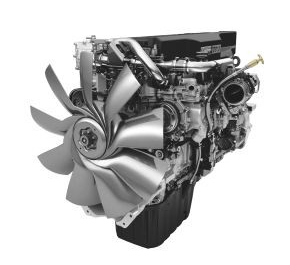Today’s engines get to the sweet spot sooner and stay there longer, and you may not need as much horsepower as you used to. Give careful consideration to both torque and horsepower when spec’ing a new truck.
Back in the late 1700s, when Scottish inventor and mechanical engineer James Watt was pondering how to measure the pulling power of horses hauling loads of coal in a mine, the word horsepower had a literal meaning.
Today, the word is used to convey the conversion of fuel energy to mechanical energy that keeps a vehicle moving, whether the vehicle is a truck, a lawn mower or a vacuum cleaner. And, for many years, horsepower was of primary importance to anyone planning to purchase a truck.
Today? “Not so much,” says Brian Daniels, powertrain product manager for Daimler Trucks North America. Daniels clarifies: “Yes, horsepower is the energy that maintains a vehicle’s momentum, but the value really lies in the relationship between horsepower and torque. Torque produces the force that gets the vehicle rolling in the first place.”
“You can stay in gears longer and still have the performance and drivability you need, without vibration."
—Brian Daniels, powertrain product manager, Daimler Trucks North America
Vocational trucks rarely operate at highway speeds but, at the bottom of a steep grade, a dump truck with a 50,000 pound load of gravel needs a good launch at the hill, and that requires torque in combination with the right transmission and axle ratio. So Daniels advises careful consideration of both torque and horsepower when spec’ing a new truck. “Talk to your Freightliner® dealer about the load your new truck typically will carry and on what kind of roads,” says Daniels. “There has been a trend toward ‘downspeeding,’ and, if spec’d correctly, you can have an engine that operates efficiently at lower RPMs, and still pulls the loads you need in your business.”
In the past, heavy duty vocational trucks may have had 550 horsepower and 1,950 lb-ft of torque to get the load rolling. Today, 470 horsepower engines with 1,850 lb-ft of torque can do the job. These newer engines get better low-end torque than engines did a few years back and with that comes higher horsepower at lower RPMs to get the load rolling. However, taking advantage of the lower operating range of today’s engines requires appropriate gearing to maintain startability in vocational applications. To get the additional benefit of the new lower RPM capabilities, look for updated shift schedules to ensure drivers learn to operate the engines in a lower RPM range.
 |
| With a Detroit™ DD13® engine (shown), you can operate down at 1,200 or even 1,100 RPMs and still provide close to maximum torque for the rating selected. |
“Today’s engines get to the sweet spot sooner and stay there longer,” says Daniels. “In a Freightliner heavy duty vocational truck with a Detroit™ DD13® engine, you can operate down at 1,200 or even 1,100 RPMs and still provide close to maximum torque for the rating selected. You can stay in gears longer and still have the performance and drivability you need, without vibration,” says Daniels.
Knowing how you want to use your truck has a big bearing on how you spec horsepower and torque. It’s no longer all about horsepower. Just as horsepower no longer is about horses.
This article was redistributed with permission from the Freightliner Severe Duty Report enewsletter. To sign up for the enewsletter visit FreightlinerTrucks.com.